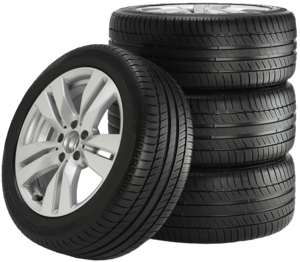Most of us don’t think much about the tires we drive on until one of them goes flat. Give us a call we would love the opportunity to provide you a quote for your tire needs.

Most of us don’t think much about the tires we drive on until one of them goes flat. Give us a call we would love the opportunity to provide you a quote for your tire needs.

Your car's tires are easy to forget about, but the truth is they are one of its most important safety features. It's the tires that come between you and the road, and problems with your tires can contribute to an accident. We are ready to help you with all of your tire needs. Our trustworthy team can do the job.
When it comes to tires, you have many options to choose from, and using the right tire for the job you have is important to keep yourself safe on the road. The mechanics at our shop are ready to help you find the right tires for your need. Some options to consider include:
All Season Tires – All season tires are great for winter weather. They give you great traction.
Passenger Car Tires – These are great for most passenger vehicles. However, if you plan on towing with your truck or SUV, you'll want something more rugged.
Summer Tires – Summer or ultra-high performance tires aren't going to give you a good grip on icy roads. Also, in temperatures below 45 degrees, the rubber will harden and decrease tire flexibility. These work great in warm temperatures.
All-Terrain Tires – All-terrain tires work well for trucks that will be towing or going off-road. They are more durable and offer better performance in rough driving conditions than other tire types.
We see a variety of problems with tires that come through our doors. From flat tires to tires that are not properly inflated, we want to help you use your tires well. Some of the more common problems we see with tires include:
Underinflated Tires – Underinflated tires have less air pressure than recommended by the manufacturer. Underinflated tires hurt your gas mileage.
Overinflated or Overloaded Tires – This problem occurs when the tire is inflated beyond the manufacturer's recommendations. This can give you a rougher ride and also cause uneven wear on your tires.
Old, Worn Out Tires – Tires need tread to properly trip the road. If the tread has worn to 4/32-inch or less, you are not safe on the road. Also, if the tread is wearing unevenly, you could be at risk for a blowout. Even if the tires aren't worn, if they are six years old or older, they should be replaced because the integrity of the rubber starts to break down.
To make sure your tires are inflated properly, check the manufacturer's recommendations on the door of your vehicle or in the owner's manual. If you aren't sure how to check tire pressure, stop into our repair shop for help.
If your car's handling seems off or if you know you have a problem with your tires, give us a call. With safe, quality tires, you will get the best performance from your vehicle and ensure a safe ride for yourself and your family.